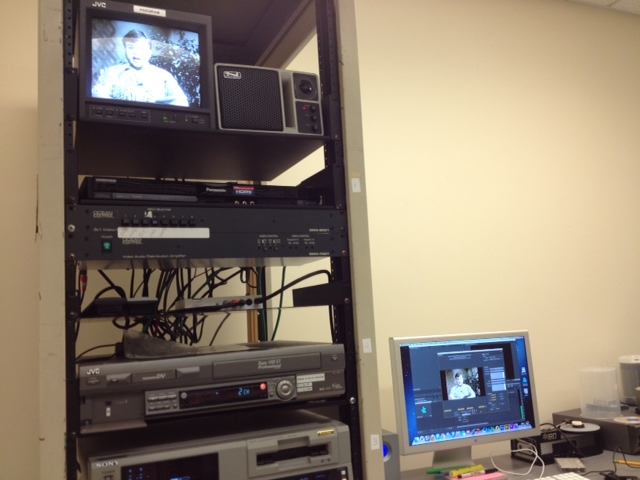Converting Analog Video to Digital: The Basics
Linda Lashendock
April 18, 2014
Forty years ago people were video recording movies, television shows, celebrations, and events (political & current) on film or via analog tape (VHS, Beta, U-Matic, etc.). Today, people are using state-of-the-art video cameras such as professional digital cameras, iPads, and smartphones to capture video content. With these technologies it becomes vital to preserve both analog and born digital video content. However, as of now there are NO effective national best practices for video format preservation. In other words, if these video formats are not being preserved in a Digital Asset Management System (D.A.M.S.) solution, media chaos occurs in the future. According to the Association of Moving Images Archivists (AMIA) it is predicted that video national best practices for digitizing, compressing video files, and attaching metadata to the video files will be established within 25 years by 2039. Even though there are no best D.A.M.S. solutions, there are many vendors who are selling digital asset management solutions for huge sums of money which may or may not be sustainable in the future. Is there an innovative and economical way to create a D.A.M.S. solution for the video content by digitizing, creating uncompressed and compressed video files and attaching metadata to video files until there are best practices? YES!Recently, I have researched what the deterioration risks are for analog tapes, obsolete equipment, and external hard drives. Analog video quality will deteriorate for many reasons within 10 years including loss of the magnetic signal on the physical analog tape, storage of films, and improper environment controls for video content. In addition, video quality deteriorates each time you watch the media. As well, your analog media players can destroy your video content when the machine malfunctions. The George Blood Video/Audio Company believes in less than 5 to 10 years analog playback decks will be obsolete. Manufactures are not producing the machines and the analog parts are hard to come by. External hard drives generally have a lifespan of 20 years. Furthermore, external hard drives lose data at 38% by failure of the actual hard drive; 30% of hard drives have readable corruptions which prevent access to the media data; 13% of hard drives are attacked by a virus; and 12% of loss will occur due to general use. This is according to the International Association of Sound and Audiovisual Archives (IASA).
So, how does one create an innovative and economical solution to capturing analog and born digital video formats and converting the content into uncompressed and compressed video files with metadata attached?
The Digital Asset Management System (D.A.M.S.) technical architecture needs to include a rack of analog decks in order to accommodate the analog playback decks with the appropriate software to digitize, compress the files, use appropriate software to attach metadata, and save the video files in a stable format to a stable location (which could be a server or a cloud). If your technical architectural design for your video collections is completed properly, you will minimize the chances of your media content being lost. The D.A.M.S. processes need to be established according to factors that include time, staff, money, equipment, and software available. It is important to create D.A.M.S. guidelines and workflows that fit your institutional needs and resources. Once you digitize and compress your analog and born digital content, it is crucial to create and attach metadata to the digital files. Without metadata and descriptive content, your video files become almost impossible to find by your end users. It is recommended that the original films, analog tapes, and born digital formats are returned to their original storage environments.
There are many reasons to convert your legacy video content to a digital archive solution such as a D.A.M.S. or a content management system. People think that storing and managing your video files on YouTube or other internet/social media platforms is the best way to go. I say, NO because of the video resolution of those video files are not good enough for future use in a project or for long-term preservation. However, sites like YouTube are a great place to put video files for access and discovery purposes. Typically, the cost of an innovative and economic system can be less than 15K. Lastly, market your video files so people can become aware of this wonderful resource for learning, teaching, and sharing!
The conclusion of creating a D.A.M.S. solution is fairly easy and cost-effective by taking the time to invest in finding the analog decks, appropriate personnel in setting up the D.A.M.S. system, and hiring the right people who are knowledgeable of analog and video files formats. I believe in training employees on the digitization guidelines that you create, in addition to performing quality control checks on metadata is crucial to the success of digitizing and compressing your analog and born digital collections. A video file in a D.A.M.S environment is a lot of things to me which includes ingesting, compressing, metadata writing, archiving, managing, and distributing the video files to your users. In planning and implementing this innovative and economical D.A.M.S. solution, it is possible to connect your video collections with your end users, and celebrate your achievements in the preservation of video history. Whether it is for professional or personal reasons, this D.A.M.S. solution will provide you with the video history that will live to tell a visual story for years to come.
To view analog videos that the Elon University Archives and Special Collections has digitized, click here.

Leave a Reply